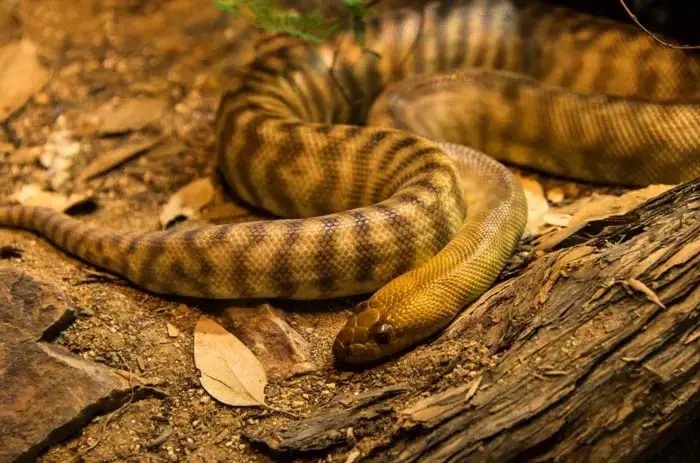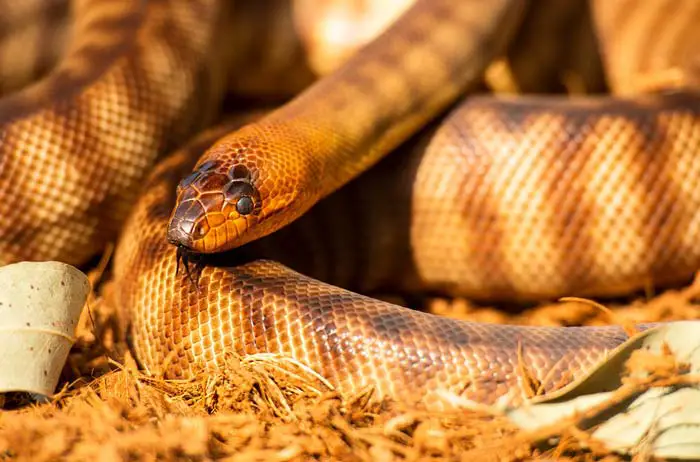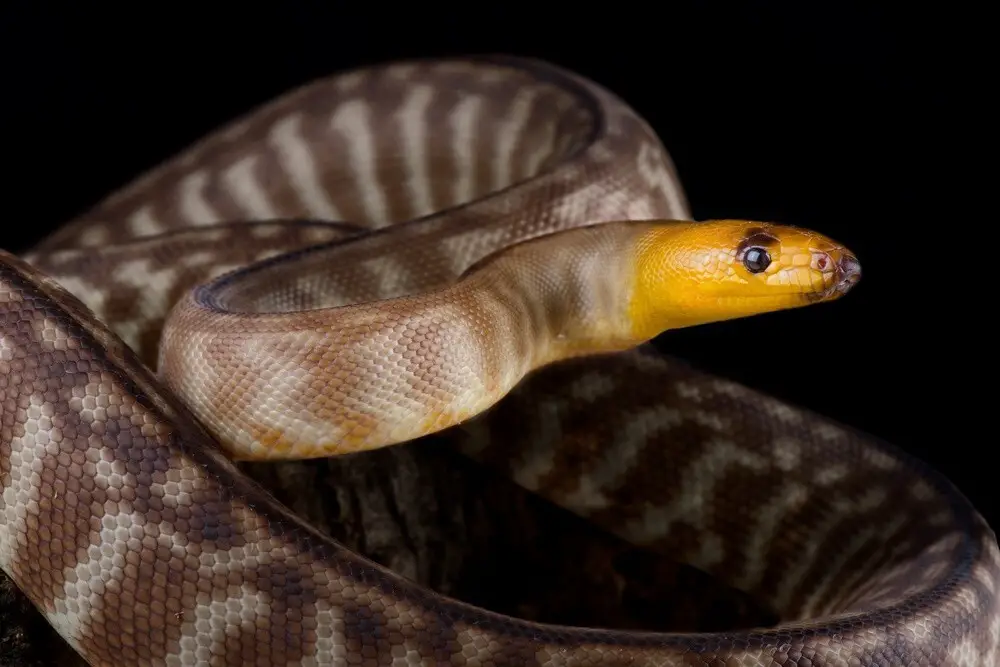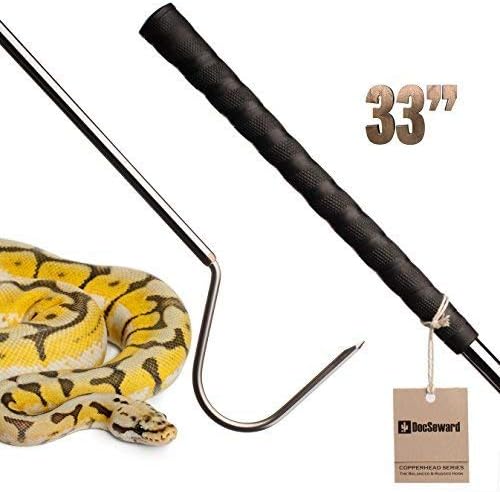The Woma Python (Aspidites ramsayi) is a fantastic snake to look at and to own! They are docile and seem to enjoy being handled once socialized appropriately. They have minimal care requirements owing to their semi-arid origins in Western Australia.
As their name indicates, they are part of the python family, however, they are much easier to handle than an 18-foot Reticulated Python and they have a much better attitude than Blood Python.
The Woma Python is also part of an elite group of snakes that are immune to another snake’s venom! This means that venomous snakes are part of their natural diet!
| Common Name: | Woma Python, Sand Python, Ramsay’s Python, Woma |
| Scientific Name: | Aspidites ramsayi |
| Natural Habitat: | Arid to semi-arid desert |
| Adult Size: | 4.5 – 7 feet |
| Lifespan: | 20 years |
| Diet: | Rodents, snakes, lizards, birds |
| Experience Level: | Beginner to intermediate |
| Enclosure Size: | 40 – 60 gallons |
Reptile Overview
The Woma Python originates in Australia in the semi-arid to arid regions of the northeast and east all the way to Shark Bay. Their natural population is in decline though due to habitat loss and ailed reintroduction efforts.
They are listed as endangered on the IUCN’s Red List. Therefore, you should ensure that your Woma Python is captive-bred and not wild-caught. Womas are fairly simple to breed, be part of the solution, and not the problem.
Womas are stunning snakes. They have beautiful coloration that sets them apart from other pythons. Their coloring combined with their peaceful natures makes the Woma Python a desirable pet for many herp enthusiasts.
Appearance
The Woma Python averages 4.5 to 7 feet in length. Some outliers reach 8 feet in length. However, these lengths in captivity are usually a result of power feeding.
Power feeding: Feeding your snake larger meals more frequently than necessary to increase size disproportionally to age for breeding purposes. Power feeding shortens the lifespan of snakes and should be avoided at all costs.
The Woma Python has a slim head not normally associated with pythons. Their head is indistinct in shape from their bodies. However, coloration makes it very discernable. They have an orange-colored head that has smooth scalation.

They have black spots over their eyes that look like eyebrows. Some owners say that this makes the snake look aggressive, others say that it makes the snake look cute or funny. What do you think?
Woma’s bodies can be a variety of colors. They can vary from pale brown to olive, to cream. These lighter backgrounds are banded by dark brown or black stripes or checkerboard patterns that do not wrap completely around the snake’s body.

Their heads are lacking in the typical heat pits found on the upper and lower lips of other pythons. This could be because they prey on other reptiles and use lure tactics rather than actively hunting.
Females are typically heavier and longer than males. Males can also appear darker in coloration.
Temperament
Woma Pythons make great pets because they are even-tempered and docile. Their defense mechanism is to musk and try to escape.
Owners are very rarely bitten by a well-handled Woma.
Behavior
Womas are nocturnal snakes. The heat of the Australian day raises surface temperatures beyond what a Woma can sustain. When they travel across sand during the day they hope and skid like a sidewinder to have minimal contact with the sand.

During the day they hide in other animal’s burrows to maintain. They widen the borrows with their heads if they need to. They are happy to burrow and spend large amounts of time underground which makes them semi-fossorial.
Therefore, they are primarily nocturnal snakes. The best time to view your snake will be at night when it is exploring its enclosure.
Lifespan
The Woma Python lives for an average of 15 to 18 years.
Some outliers live beyond 20 years of age. This all comes down to the quality of care you provide your Woma with.
If you power-feed your Woma to get it to breeding size faster than normal then you will shorten your snake’s lifespan.
Enclosure
They are active snakes at night; therefore, they need some space to roam.
An enclosure that is 40 to 60 gallons is ideal. You can go larger provided you give your Woma enough hideaways. The enclosure should be longer than it is tall. These snakes do not typically climb trees, preferring to burrow instead.
REPTI ZOO Large Glass Reptile Terrarium
The enclosure should have a screen top to encourage good ventilation. If you find that the air is becoming stagnant you can install one or two small computer fans into the screen top to encourage airflow.
The enclosure needs to be maintained carefully to avoid increases in humidity and the growth of bacteria and parasites. You can use disinfectants made special for reptile cages like Zoo Med Wipe Out 1.
Zoo Med Wipe Out 1 Disinfectant
We suggest that you do a full sanitization of the enclosure once every two months:
- To do this you must remove your snake for the full duration.
- Remove all substrate and either throw it away or sanitize it.
- You must sterilize any natural logs, branches, or rocks by boiling them. Then bake them at a low temperature to fully dry them out again.
- Wash the tank out with a 1:1 ratio of water and white vinegar solution. Make sure you rinse the enclosure with clean water after this.
- Sanitize any hideaways and water dishes in the enclosure.
- Ensure everything is 100% dry before reassembling the enclosure and returning your snake.
Enrichment is an important thing to consider as it has a direct impact on your snake’s mental health. Make the enclosure an interesting place to be for your snake without overcrowding it.

You can use rocks, logs, and dried spider wood to make the enclosure an interesting place to live. When you do a full clean out change the layout up a bit. But try not to rearrange too drastically as this can cause your snake stress.
Make sure the enclosure is escape-proof. Woma’s heads are quite narrow so they can escape out of small gaps in the screen netting. They can also push lids and doors open so make sure they are secured with clips or locks.
Substrate
The Woma Python comes from desert regions in Australia. Therefore, they need minimal humidity. Which means their substrate should not retain any moisture.
Large-pebbled, smooth sand is appropriate if you are wanting a more natural look to your enclosure set-up. If you use sand, it needs to be fully sanitized anytime there is a large mess or every two months.

However, newspaper, paper towel, and butcher’s paper are perfect substrate options too. They are all cheap, do not harbor moisture, and readily available. You can use aspen mulch or cypress shavings.
These can retain moisture so you will need to work at keeping the humidity levels under control.
Never use pine or cedar wood! They are toxic to snakes and can cause skin irritation as well as respiratory issues.
Spot clean your chosen substrate daily for fecal messes.
Temperature
Your Woma Python must have a controlled temperature gradient. They need to be able to thermoregulate (warm-up and cool down their bodies) to maintain metabolic processes such as digestion.
- Cool Side: 75°F
- Warm Side: 85°F
- Basking Area: 90°F
We recommend using an under-tank heating mat under a third of the enclosure. This will help you create the warmer and cooler sides of the enclosure. Control the heating mat with a thermostat to avoid mistakes.
VIVOSUN Reptile Heating Pad with Digital Thermostat
Use a heat lamp on one side of the enclosure to create the basking spot. The lamp must be in a protective dome to prevent your inquisitive Woma from burning itself.
Put the heat lamp on a timer as it must not affect the natural photocycle. For this purpose we recommend to use Zilla Digital Timer.
Put a hideaway at the warm temperature mark and one on the coolest side of the enclosure.
The hideaways should be large enough for the snake to fit its entire body in but small enough that it is a snug fit and makes the snake feel safe like it is in a burrow. They must not be transparent at all. They should provide a dark refuge for your snake.
They can be little caves, upturned plastic containers, hollowed-out logs, or anything else that will provide sufficient darkness.
It is important that you provide your snake with some cover to move between the hideaways. They can be rocks, logs, or sanitized scraps of denim.
Do not let the temperature get above 90°F at any time. This can be fatal for your snake.
Lighting
Woma Pythons do not require full-spectrum lighting. However, they can benefit from it.
If you are using heating pad as source of heating, we recommend to use LED lighting for your terrarium. It doesn’t create additional heat and uses less energy.
Zoo Med Reptisun Led Terrarium Hood
Your Woma is naturally nocturnal so maintaining a 12/12-hour light/dark photocycle is essential to its health.
We recommend putting any lights on a timer to prevent accidents from happening. As we mentioned before we recommend to use Zilla Digital Timer.
Any additional lighting must be put in protective domes to prevent burns to your snake.
You can put the enclosure in a room that receives natural daylight. However, make sure that no direct sunlight falls on the enclosure as it will raise the internal temperature enough to kill your snake.
Humidity
Humidity is not a big factor for the Woma Python provided it is kept at a minimum. You do not need to do anything to increase or maintain the humidity levels at all.
The Woma comes from a semi-arid to arid desert region. This means that the enclosure needs to mimic this as closely as possible.
High humidity levels (50%+) will cause respiratory issues or blisters to form on the scales.
During shedding time, add a humid hideaway to the cold side of the enclosure to aid in the shedding process. Line a box with some damp paper towels or sphagnum moss and lightly mist it once a day. Remove the box once shedding is complete.
Galápagos Terrarium Sphagnum Moss
The humid hideaway must be on the cooler side of the enclosure to prevent rapid evaporation increasing the overall humidity levels.
Diet
Woma Pythons do not need huge amounts of water. Place a small water dish in the enclosure every evening and remove it in the morning. This dish should not be large enough for the sake to get into, Woma’s do not soak themselves.
The water dish should either be anchored or heavy enough that it will not be tipped over. If the water dish is tipped over it will increase the humidity levels in the enclosure to an unhealthy level.
Provide your Woma with clean water every day. It is important that your snake does not drink stale or old water.
Womas will eat as often as you provide them with food. Therefore, it is important to keep them to a weekly or bimonthly feeding routine.
We suggest feeding your Woma one prey item of appropriate size once a week. Use our prey sizing guide to help you:
Largest point of girth of prey = largest point of girth of the snake.
Womas eat small mammals, birds, and other reptiles in the wild. In captivity, they should be kept on rodents.
We always recommend frozen/thawed prey. Frozen/thawed prey items do not carry parasites and cannot harm your snake. Feeding your snake live prey also comes with the additional costs of keeping that live prey.
When it comes to feeding your snake, place the frozen prey item in a hot bowl of water until the prey is fully thawed. Never feed your snake partially frozen pray as the temperature difference will be fatal.
If your snake is a reluctant eater then you can scent the frozen/thawed prey item by rubbing it on another reptile such as a bearded dragon or another snake.
You can vary your Woma’s diet by including frozen/thawed chicks.
Handling
Woma Pythons are lovely snakes to handle. They are calm and even-tempered and do not try to escape when being handled.
Occasionally Womas can have a high prey drive. If your snake has a high prey drive then use a glove to make yourself more comfortable. If you are more comfortable then your snake will be more comfortable with being handled.
Always sanitize your hands before dealing with your reptile especially between dealing with two different reptiles as they are very susceptible to parasites.
When you remove your Woma python from its enclosure make sure to support its body weight.
These are hefty snakes as they grow up so make sure that they feel secure in your hands when you handle them. You can achieve this by keeping the snake close to your body.
If it makes you feel more comfortable you can hook train your Woma python. To do this gently nudge your python when you want to handle it with the hook. Once it is aware of your presence you can then gently hook the python out of its enclosure.
This means that your python will come to associate the hook with handling and not food. It is important to note that Woma Python bites are very rarely reported by owners.
We recommend handling your Woma Python at least once a week. This will help keep it socialized throughout its life.
Never handle your python 24 hours prior to, during, or for 48 hours after feeding. This can cause your python to regurgitate its meal.
When you handle your snake make sure that your clothing or hands do not smell like their prey items as this can encourage them to bite as they may mistake your fingers for their prey items.
Potential Health Issues
Parasites
All snakes are susceptible to parasites. Mites are a major concern for snake owners. They are visible as small black or red dots on your snake or the substrate.
Mites burrow under the scales to get at the blood and skin of your snake. If your snake has mites, it is an indication of poor enclosure hygiene.
You will need to do a full sanitization of the enclosure and get your snake treated for a mite infestation.
Scale and Mouth Rot
If the humidity levels are too high your snake can suffer from a bacterial infection of its scales, nostrils, or mouth. Scale and mouth rot must be addressed immediately by a vet.
Your snake will have a bright red mouth, skin irritation, or pus oozing from its nostrils.
Respiratory Problems
If the humidity levels are too high your Woma python will develop a respiratory infection. You will notice that your snake starts gurgling, wheezing, and bubbling from its mouth and nostrils.
Your snake will also tend to breathe through its mouth instead of its nostrils if it has a respiratory infection.
Obesity
A fat snake is not a funny snake. Woma pythons are good eaters and will eat whenever offered food. This means that they are susceptible to obesity.
Obesity puts additional strain on the heart and liver and other internal organs and will lead to death. Stick to a structured feeding regime with your Woma python.
Breeding
Male and female Woma pythons reach sexual maturity at 3 to 4 years. Some breeders power feed their pythons to increase their size before 3 to 4 years so that they can breed them earlier.
Power feeding your snake will shorten its lifespan and is an unhealthy and unethical practice.
Your pythons will need to undergo a period of brumation. This is a period where they would have experienced a seasonal cooling in their natural habitat. During this time a male python’s sperm develops and a female’s follicles mature.
To brumate your pythons you will need to lower their daytime and nighttime temperatures by 5° to 10° Fahrenheit.
You can do this by adjusting the thermostat that controls the under-tank heating mat. Or turn the heating pad off completely at night and turn it back on in the morning.
You will also need to adjust their photocycle to 14 hours of dark and 10 hours of light. This period of brumation must happen over a 3 to 5 months period.
Gradually start lowering their temperatures and adjusting their light cycle in October.
During this period males and females may refuse food. You can introduce your male to your female’s enclosure now.
Females and males will mate continuously through these months until the male is certain she is gravid.

During this time remove the male once a week to feed him. You can offer the female food at the same time but she may refuse it.
In the month of April, remove the male and return him to his enclosure and return their temperature and light settings to normal.
Your female should now be gravid which means pregnant. She may refuse food until she lays the eggs. Provide your female with a nesting box. The box should be big enough for her to fit in and turn around completely. You can line the box with newspaper, paper towels, are butchers’ paper.
The female will lay her eggs between May and August. The average clutch of eggs is between 5 and 20.
You will know that the female is about to lay her eggs when she turns her belly to the side and starts basking more.
Once she lays her eggs you have a very limited amount of time to remove them before they start sticking together. You do not need to incubate them separately as your Woma Python will do it for you!

Your eggs will hatch in the next 60 days. Once they hatch, they are completely independent and must be removed from the female’s enclosure.
Conclusion
Woma pythons are wonderful pets. They are even-tempered, good eaters, require minimal upkeep in terms of humidity, and are great for handling.
If you are a beginner herp enthusiast or you are looking to own a larger snake in the python family but not quite ready for something like a Ball or Scrub Python then the Woma python is for you.
We ‘herp’ you enjoy your journey with your new best friend.
Related:










